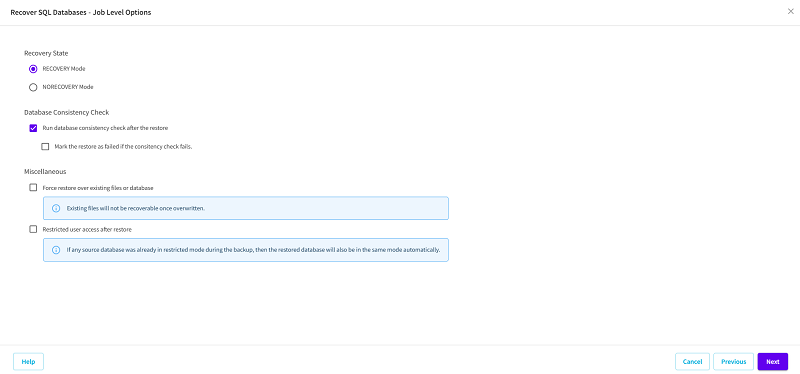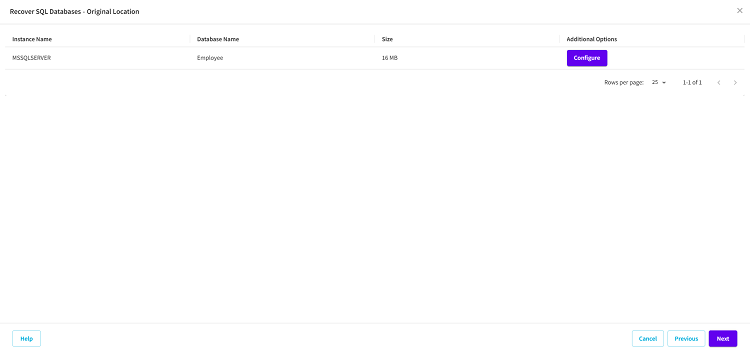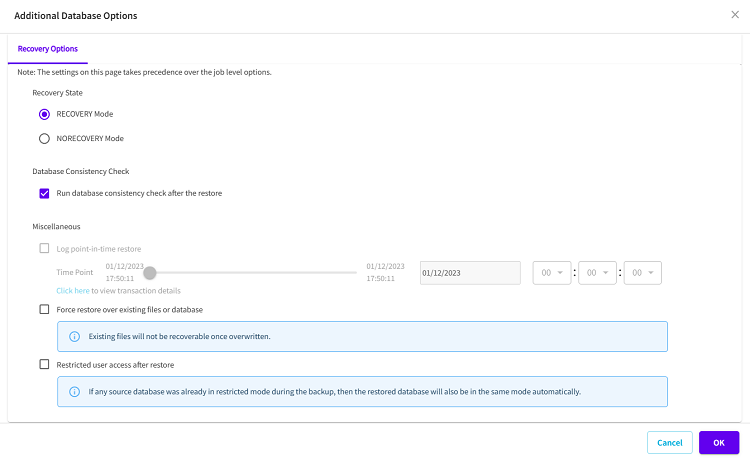Restore SQL Databases
This section provides information about restoring the Microsoft SQL databases.
Follow these steps:
- Navigate to Protect > Sources.
- From the list of available sources, click the Action drop-down list of a source that you want to recover, and then click Start Recovery.
- The Restore wizard appears.
- On the Restore wizard, select RPS.
- The Restore wizard refreshes and displays the available recovery options.
- Select Recover SQL Databases.
- The Recover SQL Databases wizard appears.
- From the Recovery Point Date section, select a date.
- The corresponding recovery points for that date are displayed, with the name of the backup, size of the file or folder, and the date of the backup performed with time.
- Note: If the recovery point you are attempting to restore is encrypted, the Encryption/Session Password dialog opens and prompts you to enter the encryption or session password.
- Select the SQL datastore to restore, and then click Next.
- Select the restore destination, and then click Next.
-
- The available destination options are:
- Restore to original location
- Note: For agentless machine, the Restore to original location and Restore to alternative location options are disabled.
- The Recover SQL Databases - Job Level Options page appears.
- On the Recover SQL Databases - Job Level Options page, do the following, and then click Next:
- Recovery State
- RECOVERY Mode: By default, this option is enabled. It makes the SQL database online to allow data recovery and provides you permission to access the restored database. For an example of restoring to the original location using RECOVERY Mode, see RECOVERY Mode Example.
- NORECOVERY Mode: The database transitions to a ‘RESTORING’ state to prevent users from accessing the database. To restore the last backup and bring the database online for usage, use the RECOVERY Mode option. For an example of restoring to the original location using NORECOVERY Mode, see NORECOVERY Mode Example.
- Database Consistency Check
- To make sure that the database is consistent after a restore, select the Run database consistency check after the restore check box. This option checks the physical and logical integrity of objects in an SQL Server database. The Mark the restore as failed if the consistency check fails option indicates when the restore job fails if the database consistency check fails for the selected database.
- Miscellaneous
- Force restore over existing files or database: This option overwrites the existing database files located at the restore destination. Not selecting this option for an existing database file can make the restore incomplete. You can skip this option when the database file is new.
- Restricted user access after restore: This option restricts access to the database file for a specific group of users such as sysadmin, dbcreator, and/or db_owner. These users have permissions to modify the database.
- Note: If the source database was already in the restricted mode during the backup, the restored database automatically stays in the same mode.
-

- Do one of the following based on the restore destination selected:
- On the Recover SQL Databases - Original Location page, to configure or change the configuration at a database level, click the Configure button.
-

- The Additional Database Options dialog appears.
- Verify and make any changes to the database options, as needed, and then click OK to return to the Recover SQL Databases - Original Location page.
-

- Click Next.
- The Recover SQL Databases -Summary page appears.
- Review the displayed information to verify that all the restore options and settings are correct, and then do one of the following:
- If the summary information is incorrect, click Previous and go back to the applicable dialog to change the incorrect setting.
- If the summary information is correct, click Start Recovery to launch the restore process.
- On the Recover SQL Databases - Alternate Location page, click the Destination Instance Name drop-down list to view the size and the FileStream enabled status of the selected database.
- Note: If a database is FileStream Enabled, the Destination Instance Name field lists only FileStream Enabled servers. However, if the FileStream is not enabled, the Destination Instance Name displays both FileStream enabled and disabled databases.
- To rename the database, type the New Database Name as needed.
- To configure or change the configuration at a database level, click the Configure button.
-

- The Additional Database Options dialog appears.
- In the Recovery Options tab, verify and make any changes to the database options, as needed.
- In the Database Settings tab, do the following:
- To select the Destination Location, click the (…) button.
- Note: When you change the destination location, it also updates the destination for all the database files.
- Under File Name Settings (Optional), you can change the file names partially or fully. To replace the file name, type the new file name in the Replace With field.
- Click Apply to make the changes.
- Note: The new file names appear under the Destination File Name column.
-

- Click OK to return to the Recover SQL Databases - Alternate Location page.
- Click Next.
- The Recover SQL Databases - Summary dialog appears.
- Review the displayed information to verify that all the restore options and settings are correct, and then do one of the following:
- If the summary information is incorrect, click Previous and go back to the applicable dialog to change the incorrect setting.
- If the summary information is correct, click Start Recovery to launch the restore process.
- Notes:
- After the restore finishes, view the restore status along with the rename of the database in the Logs page.
- The change in the database name reflects in the SQL Management Studio.
Restores to the original location from where the backup image was captured.
Dump file only
For this option, Arcserve UDP Agent (Windows) dumps the selected Microsoft SQL database files to the specified folder. When you select this option, you can specify or browse to the folder location where the dump file needs to be restored.
Restore to alternative location
Restores to an alternate location (not the original location).
The restore of Microsoft SQL database is started successfully.
